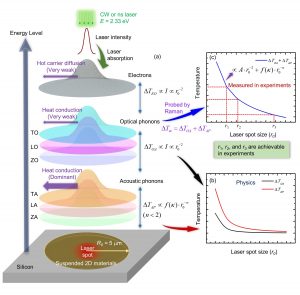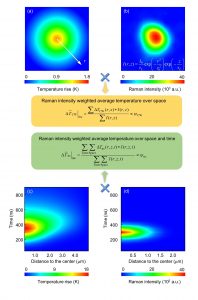A team of researchers have developed a novel way of distinguishing the atomic and molecular level thermal non-equilibrium in nanoscale materials, which can have a significant impact in the area of heat transfer according to one Iowa State University professor.

Xinwei Wang, professor of mechanical engineering (ME) at Iowa State, was one of the authors on the paper titled “Distinguishing Optical and Acoustic Phonon Temperatures and Their Energy Coupling Factor under Photon Excitation in nm 2D Materials,” recently published in the journal Advanced Science. Other authors on the paper represent various universities in China, including first author Ridong Wang (no relation to Xinwei), an associate professor at Tianjin University who graduated with his Ph.D. in ME from Iowa State in 2019 and worked in Xinwei Wang’s lab as a graduate student.
“In our work, we designed a unique and advanced technique to construct different energy transport states using continuous laser and nanosecond laser irradiation and simultaneous Raman measurement. For the first time, we distinguish the temperatures of optical phonons and acoustic phonons, and measure the intrinsic thermal conductivity of 2D materials,” Xinwei Wang said, adding that they also reported the first energy coupling coefficient between optical phonons and acoustic phonons.

The project built upon past research Xinwei Wang has conducted using Energy Transport State-resolved Raman (ET-Raman).
“This is a very promising technique that pushes the thermal probing to the nanosecond and picosecond limit,” said Wang. “It provides unprecedented accuracy and high-level measurement of interface thermal resistance, thermal conductivity, and hot carriers diffusion in 2D atomic layer materials.”
Wang applied various ME concepts and methods to this project including thermal conductivity, heat conduction, numerical modeling and thermal nonequilibrium. He conducted many of the experiments in his Micro/Nanoscale Thermal Science Laboratory on the Iowa State campus with the assistance of Hamidreza Zobeiri, a Ph.D. student in ME at Iowa State and an author on the paper.

The data processing, analysis, physics interpretation and writing was done collaboratively with the other researchers. Wang said that for complicated scientific problems, such as the ones addressed in this paper, international and interdisciplinary collaborations are key to analyze the problems from different perspectives and find the best solutions.
Once further developed, Wang said the findings from this research can be applied to various industries outside of academia, some of which are particularly relevant in Iowa.
“The techniques developed in this work can be readily applied to study the dynamic chemical processes in biomass pyrolysis for biomass-to-fuel conversion. Also, the findings will find broad applications in the solar cells and semiconductor industries,” Wang said.
Support for this project was provided by the National Science Foundation.